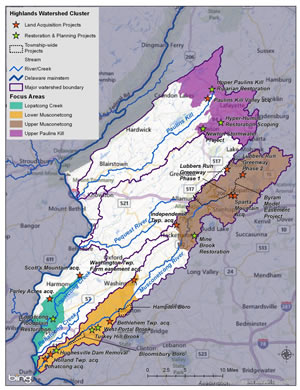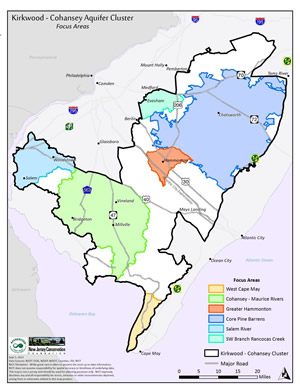Projects & Programs - Keep the Rain from the Drain
William Penn Foundation - Technical Support Program for Municipalities and Watershed Partners
In 2016, the William Penn Foundation began an initiative to assist communities within the William Penn Highlands and Kirkwood-Cohansey Cluster Areas in their efforts to address stormwater runoff and water quality. Located in environmentally sensitive areas, critical to the health of the New Jersey Highlands and Pinelands, these communities have the opportunity to implement many forms of green infrastructue. To help with this effort, the William Penn Foundation has entered into a partnership with the Rutgers Cooperative Extension Water Resources Program.
Source: New Jersey Highlands Watershed Cluster Implementation Plan |
Source: Protecting and Restoring Places of Ecological Significance - An Implementation Plan for the Kirkwood-Cohansey Aquifer Cluster |
In light of our expertise and our meetings with the William Penn Kirkwood‐Cohansey Cluster and the New Jersey Highlands Cluster, the Water Resources Program will:
- Educate municipal officials and provide them with the tools they need to successfully implement and enforce stormwater regulations for new development projects
a. Deliver two (2) Asking the Right Questions in Stormwater Review workshops
b. Deliver two (2) Municipal Information Sessions to address municipal‐specific questions from the Asking the Right Questions in Stormwater Review workshop and E‐Learning tool
c. Review 4 municipal approved development plans and provide detailed summary/report of stormwater management compliance with current New Jersey regulations (2 municipalities from each cluster group)
- Assist communities in evaluating the water resources impacts of existing development in their municipality and provide them with specific mitigation projects to restore groundwater recharge, improve water quality, and reduce flooding
a. Develop 20 municipal impervious cover assessments (10 municipalities from each cluster group)
b. Develop 20 municipal impervious cover reduction action plans (10 municipalities from each cluster group)
c. Implement 6 municipal demonstration green infrastructure projects, including engineering design calculations, plans, and implementation (3 municipalities from each cluster group)
d. Develop a summary report with recommendations on local ordinances
1 a. & b.:
1 c.:
The RCE Water Resources Program has reviewed plans for major development in ten towns. The five towns in the New Jersey Highlands Cluster include Newton, Hampton Borough, Phillipsburg, Lopatcong Township, and Bryam Township. The five towns in the Kirkwood-Cohnasey Cluster include Pilesgrove Township, Woodstown, Upper Deerfield Township, Bridgeton, and Vineland. The plan review indicated that many of the municipalities are ensuring that major development is in compliance with the stormwater, but few are using green infrastructure practices. Some developments are using manufactured treatment devices coupled with a traditional extended detention basin. This allows them to achieve their 80% total suspended solids removal requirements while reducing peak runoff flow rates. A detailed summary report is provided below.
- Green Stormwater Infrastructure Database Research, April 17, 2018 (PDF)
2 a. & 2b.:
Municipalities in the New Jersey Highlands Watershed Cluster and the Kirkwood-Cohansey Aquifer Cluster:
Links are provided to the impervious cover assessments (ICA), impervious cover reduction action plans (RAP), and feasibility studies completed to date for each of the municipalities in the project area.
Alpha |
|
Branchville |
|
Greenwich |
|
Hackettstown |
|
Hampton Borough |
|
Hampton Township |
|
Washington Borough |
|
Hopatcong |
|
|
|
|
|
2 c.:
The RCE Water Resources Program worked with cluster partners to construct demonstration projects in six municipalities. In the Kirkwood-Cohansey Cluster the following municipalities had projects implemented: Woodstown, Elmer, and Bridgeton, NJ, and in the Highlands Cluster the following municipalities had projects implemented: Harmony, Lopatcong, Upper Deerfield, and Pohatcong, NJ. The construction of these rain gardens was completed with the help of the municipality’s Department of Public Works and cluster partners. The RCE Water Resources Program has constructed six rain gardens and has conducted a slope stabilization, invasive plant removal, and native plant planting project. Listed below are the six projects and their location. The maintenance manual, site plan, planting plan, concept drawing, and before/after photos are linked.
Kirkwood-Cohansey Cluster
Rain garden/bioswale - Buckshutem Road School, Bridgeton, NJ
Rain garden – Russel G. Garrison Memorial Park, Woodstown, NJ
Rain garden – Elmer Ambulance Corps, Elmer, NJ
Highlands Cluster
Rain garden - Harmony Township School, Harmony Township, NJ
Rain garden - Lopatcong Pool, Lopatcong Township, NJ
Rain garden – Pohatcong Municipal Building, Pohatcong, NJ
Slope stabilization, invasive plant removal, and native plant planting, Phillipsburg, NJ
2 d.:
The RCE Water Resources Program has completed a review that compares the stormwater control ordinances, improper disposal of wastes ordinances, and public education measures to the regulations and minimum standards that are set in the N.J.A.C 7:8 Stormwater Management, the N.J.A.C 7:14 Water Pollution Control Act, the Tier A Municipality Stormwater Guidance Document, the Tier A Municipality Stormwater General Permit, and the NJDEP Stormwater Best Management Practices (BMP) Manual. The following municipality’s ordinances and master plans were reviewed: Highland Cluster — Lopatcong Township, Hampton Township, and Newton and in the Kirkwood-Cohansey Cluster — Bridgeton, Elmer, and Upper Deerfield Township. Each municipality had a review of their town code, master plan, and website to investigate if that municipality’s ordinance requirements, regulations, and minimum standards were being met.
Project Funding Source:
William Penn Foundation

 Figure 1. Map of the New Jersey Highlands cluster with approximate project locations
Figure 1. Map of the New Jersey Highlands cluster with approximate project locations Figure 4. Project Focus Areas for the Kirkwood-Cohansey Aquifer Cluster
Figure 4. Project Focus Areas for the Kirkwood-Cohansey Aquifer Cluster